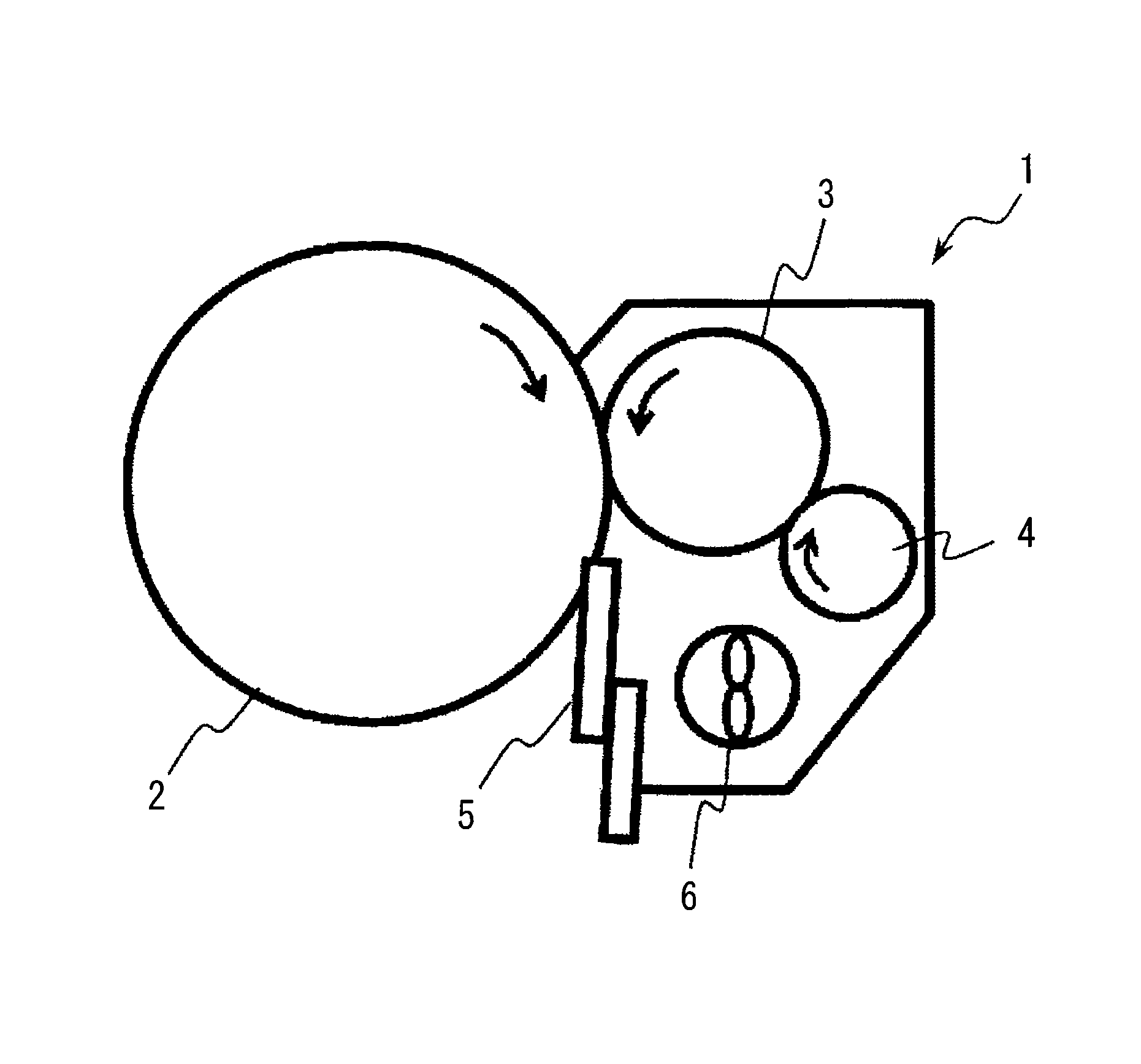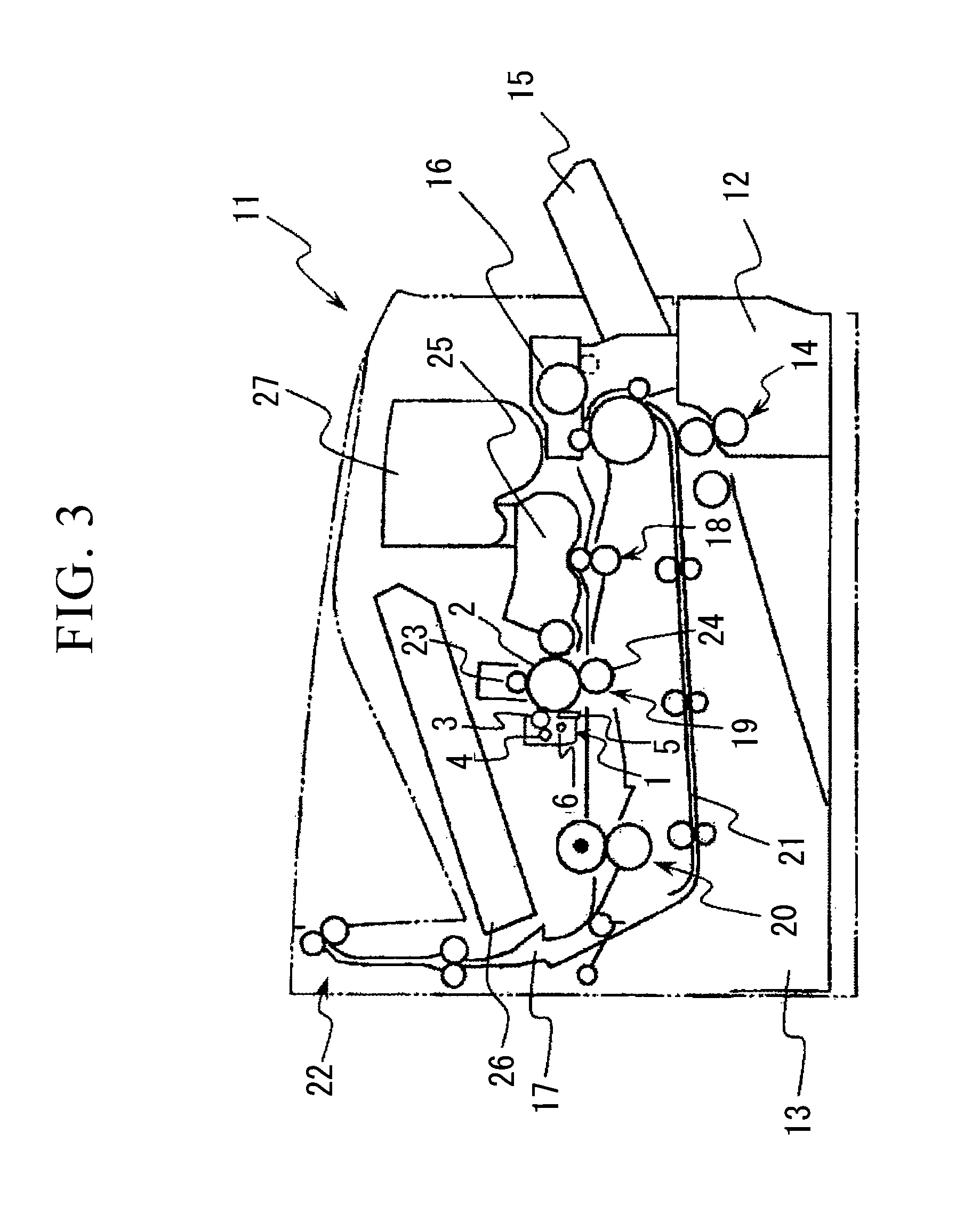Cleaning apparatus and image forming apparatus
a technology of cleaning apparatus and cleaning roller, which is applied in the direction of electrographic process apparatus, instruments, optics, etc., can solve the problems of not being able to obtain superior transfer images, not being able to maintain the thickness of the toner layer formed on the surface of the cleaning roller (d) uniform, and not being able to consistently polish a photosensitive drum
- Summary
- Abstract
- Description
- Claims
- Application Information
AI Technical Summary
Benefits of technology
Problems solved by technology
Method used
Image
Examples
example 1
[0100]A cleaning apparatus according to an embodiment of the present invention was loaded (mounted) in an image forming apparatus (a TASK alfa 500ci), and the thickness of the toner layer formed on the cleaning roller after printing was evaluated.
[0101]A cleaning apparatus provided with the structure shown in FIG. 1 was used, and urethane foaming rubber (having an outer diameter of 15.5 mm and a thickness of 1.75 mm) was used for the cleaning roller, a urethane rubber plate (having a thickness of 2.2 mm) was used for the cleaning blade, and a sponge roller (made of urethane having an outer diameter of 11 mm and a thickness of 1.5 mm) was used for the toner layer thickness regulating roller. Moreover, the outermost layer of the photosensitive drum was formed from amorphous silicon, and titanium oxide (TiO2) was externally added to the toner.
[0102]The linear velocity of the photosensitive drum was set to 210 mm / sec, and the linear velocity of the cleaning roller was set to 168 min / sec...
example 2
[0114]A cleaning apparatus provided with the structure shown in FIG. 1 was used, and the thickness of toner layers formed on the cleaning roller was evaluated. An EPDM foaming body (having an outer diameter of 15 mm and a thickness of 2 mm) was used for the cleaning roller, a urethane rubber plate (having a thickness of 2.2 mm) was used for the cleaning blade, and a brush roller (made of conductive nylon at 120 KF / inch2, 330T / 48F, and having a shaft of 6 mm and a bristle length of 3 mm) was used for the toner layer thickness regulating roller. Moreover, the outermost layer of the photosensitive drum was formed from amorphous silicon, and titanium oxide (TiO2) was externally added to the toner.
[0115]The rotation directions of the cleaning roller and toner layer thickness regulating roller were the same direction at the point where the two rollers contacted each other, and the development of a solid pattern having a width of 50 mm in the circumferential direction of the photosensitive...
example 3
[0123]A toner layer was formed on a cleaning roller using the same method as that employed in Example 2. After the cleaning roller and the toner layer thickness regulating roller had been rotated at different speeds, the toner layer thickness was measured. The thickness of the toner layer was measured in five locations in the axial direction of the cleaning roller, and the mean value thereof was calculated.
[0124]The linear velocity of the photosensitive drum was set to 210 mm / sec, and the linear velocity of the cleaning roller was set to 168 mm / sec. The toner layer thickness regulating roller was then rotated at linear velocities of 0.6, 0.8, 1 (i.e., in slave rotation), 1.2, and 1.4 times that of the cleaning roller.
[0125]The results are shown in Table 3.
[0126]
TABLE 3Linear velocity ratioMean value of cleaningrelative to that ofroller toner layercleaning rollerthickness (μm)0.6150.8301451.2351.420
[0127]From Table 3 it was found that as the difference in velocity relative to that of...
PUM
 Login to View More
Login to View More Abstract
Description
Claims
Application Information
 Login to View More
Login to View More - R&D
- Intellectual Property
- Life Sciences
- Materials
- Tech Scout
- Unparalleled Data Quality
- Higher Quality Content
- 60% Fewer Hallucinations
Browse by: Latest US Patents, China's latest patents, Technical Efficacy Thesaurus, Application Domain, Technology Topic, Popular Technical Reports.
© 2025 PatSnap. All rights reserved.Legal|Privacy policy|Modern Slavery Act Transparency Statement|Sitemap|About US| Contact US: help@patsnap.com



